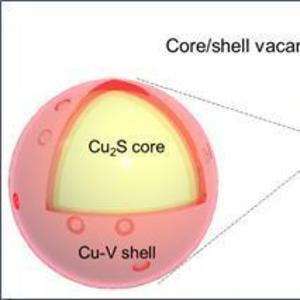New catalyst upgrades carbon dioxide to fuels found by USTC




ZHUANG Taotao
June 29, 2018
BY University of Science and Technology of China
Liquid multi-carbon alcohols such as ethanol and n-propanol are desired as renewable transportation fuels. They offer high energy densities, ease of long-range transport, and direct drop-in usage in existing internal combustion engines. Engineering catalysts that favor high-value alcohols is desired.
A research team led by professor YU Shuhong from University of Science and Technology of China of Chinese Academy of Sciences and Edward H. Sargent from University of Toronto has uncovered a catalysis strategy intermediates during CO2 electrochemical reduction reaction, which sheds new lights on upgrading CO2 to engine fuels.
Advertisement
Advertisement
When it comes to designing catalysts for CO2 conversion, many researches on the C-C coupling step have been done; while little attention has been paid to post-C-C coupling reaction.
By deliberately incorporating sulfur atoms into the catalyst core and copper vacancies in its shell, researchers realized Cu2S-Cu-V core-shell nanoparticles that enhance CO2 reduction to ethanol and propanol. Structural characterization, x-ray studies, and electrochemical measurements were utilized to illustrate how good this new catalyst is in improving catalytic performance.
Advertisement
Advertisement
This discovery will inspire the design of efficient catalysts that produce higher-carbon liquid alcohols. In addition to address the need for long-term storage of renewable electricity and decarbonization of the transportation sector via electrocatalytic reduction of CO2 to chemical feedstocks. And the results were published in Nature Catalysis on Jun 11th.
Related Stories
The U.S. Department of Energy Bioenergy Technologies Office (BETO) announced up to $23 million in funding to support research and development (R&D) of domestic chemicals and fuels from biomass and waste resources.
The U.S. DOE has announced its intent to issue funding to support high-impact research and development (R&D) projects in two priority areas: sustainable propane and renewable chemicals and algal system cultivation and preprocessing.
Sens. Sherrod Brown, D-Ohio, and Pete Ricketts, R-Neb., in August introduced the Renewable Chemicals Act, a bill that aims to create a tax credit to support the production of biobased chemicals.
The Chemical Catalysis for Bioenergy Consortium, a consortium of the U.S. DOE’s Bioenergy Technologies Office, has launched an effort that aims to gather community input on the development of new biomass processing facilities.
USDA on March 8 celebrated the second annual National Biobased Products Day, a celebration to raise public awareness of biobased products, their benefits and their contributions to the U.S. economy and rural communities.
Upcoming Events










